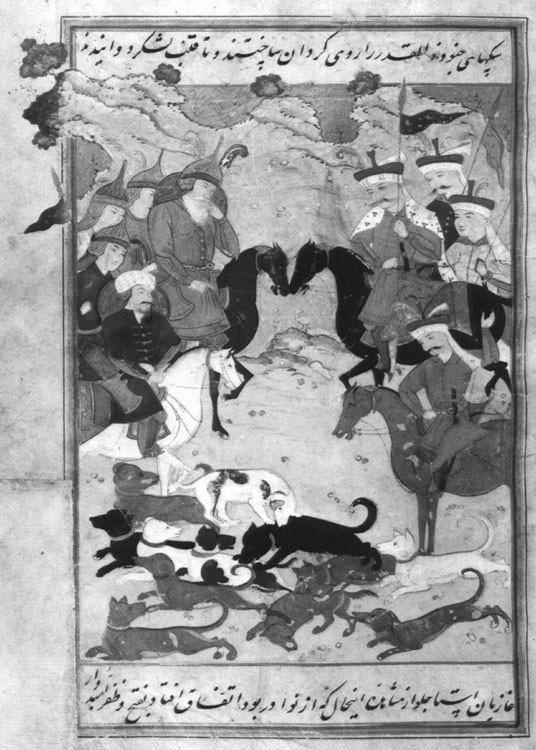In 913/1507-8 several battles were fought in the region of Diār Bakr between the Ẕuʾl-qadars under the command of various sons of ʿAlā al-Dowla, and the Safavids commanded by Khan Moḥammad ¯Ostājlu and his brother Qarā Khan. The account of these battles as related by the text varies significantly in detail from that recorded by Eskandar Monshi. The text elaborates more profoundly than Monshi, but one cannot surmise, that it therefore might be more accurate. Evidently, in the first encounter between these two forces, Qarā Khan killed two of ʿAlā al-Dowla’s sons, Sāru Qaplān and Sāru Aslān (see Ms. M, folio 87). In the second battle Qarā Khan successfully defended the fortress Qarā Ḥamid against the onslaught of two other sons of ʿAlā al-Dowla, Kur Šāhroḵ and Orduvāna Beg, the latter being severely burned in the battle. Then followed a third encounter which pitted the joint Safavid forces of Khan Moḥammad ʿOstājlu and his brother against a larger Ẕuʾl-qadar force commanded by Kur Šāhroḵ and Khan Moḥammad Ẕuʾl-qadar (not to be confused with Khan Moḥammad Ostājlu), both sons of ʿAlā al-Dowla. Monshi makes no mention of Khan Moḥammad Ẕuʾl-qadar, but rather states that the Ẕuʾl-qadars were commanded by Kur Šāhroḵ and his brother Aḥmad Beg. However, in this text it is related that Ahmad Beg was also known as Orduvāneh Beg, and Orduvāneh Beg was killed, according to Eskandar Monshi, in the first engagement between the Ẕuʾl-qadars and ʿOstājlus. According to this text Orduvāneh was burned at the siege of Qarā Ḥamid, but not killed.
The two opposing forces drew up for battle within sight of the town of Āmeda, location of the fortress of Qarā Ḥamid. According to Monshi, the Ẕuʾl-qadar forces numbered 15,000 troops and the ʿOstājlus only 3000, but these numbers seem exaggerated. Also, each side had with it an unusual number of dogs, which according to this text, included 2000 Ẕuʾl-qadar canines and 300 with the ʿOstājlus. As the two sides exchanged verbal abuses prior to battle, a strange event occurred - a number of dogs emerged from the Ẕuʾl-qadar lines and attacked the dogs of the ʿOstājlu army. As it happened, the ʿOstājlu dogs gained the upper hand, reportedly killing 500 of their attackers, and putting the remaining Ẕuʾl-qadar dogs to flight. The morale of the ʿOstājlu forces was uplifted by this event, and in the ensuing battle the Ẕuʾl-qadars were decisively defeated. Monshi claims that Kur Šāhroḵ and Aḥmad Beg were taken prisoner and slain on the battlefield. This text, however, states that Khan Moḥammad Ẕuʾl-qadar was slain on the battlefield by Qarā Khan - no mention is made of his having been taken prisoner. Kur Šāhroḵ Ẕuʾl-qadar met his fate at the hands of another person of the same name, Kur Šāhroḵ ʿOståjlu, who apparently derived his name by suffering from the same affliction of having only one good eye. Obviously stunned by the confrontation, Kur Šāhroḵ Ẕuʾl-qadar was easily unhorsed by his ʿOståjlu counterpart, taken prisoner, and thrown before Khan Moḥammad ʿOstājlu, who ordered him executed.
The dogfight is represented in the foreground of the painting. The Ẕuʾl-qadar greyhounds appear more like daschunds, and mixed in the melée are a number of mongrels, which presumably are the ʿOstājlu animals. Subsequently, it is difficult to determine which dogs belong to whom, but since they are headed for the left side of the painting, one might presume that the tide of battle has been turned and they are running for the Ẕuʾl-qadar lines. The ʿOstājlus, as represented by four mounted soldiers dressed in qezelbāš uniforms, observe the dogfight from the right side. The most prominent of these ʿOstājlus, astride a black horse, holding a lance with banner, and wearing a spotted cape is presumably Khan Moḥammad ʿOstājlu, the Safavid governor of Diār Bakr and commander of the ʿOstājlu forces. The Ẕuʾl-qadars are represented by five mounted personage in a group to the left. Two are portrayed more prominently than the rest, and presumably might represent Kur Šāhroḵ Ẕuʾl-qadar and Khan Moḥammad Ẕuʾl-qadarr, the two sons of ʿAlā al-Dowla who were in command of the Ẕuʾl-qadar forces. But the one on the dark colored horse, with white beard and mustache and a finger to his lip in astonishment, appears too old for the part, and in fact appears more aged than a representation of ʿAlā al-Dowla himself (cf. Ms. M, folio 87). The setting is on hilly ground that rises to a ridge just beyond the feet of the horseman at the center of the miniature, and rises again beyond that in a very steep craggy rock formation that looms over their heads. There are some slight suggestions of shrubbery on the upper ridge and patches of sky beyond.
Painting: 16.7 x 12.4 cm. One line of text above and below the painting. Frame encloses painting and text; rock formation, one bush, and a standard protrude beyond the frame into the left margin near the top. Minor abrasion marks but no major signs of damage. No signs of retouching. Unsigned.
Painting references:
Stchoukine, SA_1964, p.65 and pl.LXVI, where it is inaccurately captioned “Shāh Ismāʿil observe ses chiens poursuivant ceux de ses ennemis”.
Text X-references:
See Muntaẓer-Ṣāḥeb_1970, pp.228-231 for this event in the History of Shah Esmāʿil.
See Savory, SA_1979, pp.52-53 for this event in the History of Shah ʿĀbbās.
Robert Eng
Last updated: November 23, 2010
